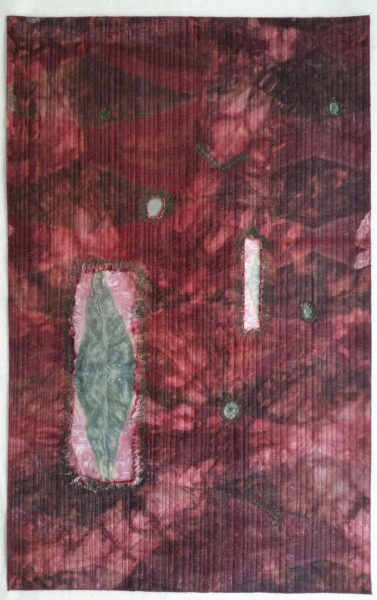Here’s what the LaDue News had to say.
Here’s an interview with the leaders of one of our partner organizations, Infant Loss Resources.
Here’s a link to Town & Style’s coverage of the St. Louis exhibition.
Here’s what the LaDue News had to say.
Here’s an interview with the leaders of one of our partner organizations, Infant Loss Resources.
Here’s a link to Town & Style’s coverage of the St. Louis exhibition.


I am ending 2023 with the first piece in a new series, “Where do we go from here?”. I feel I am at a crossroads (and our country is, too). I’m wrapping up a huge multi-year project (have you heard of it?)… supporting loved ones with serious medical issues… grieving my parents and the sense of mortality that comes with that loss.
No, I don’t have 2 actual boyfriends. The first class I took with Jane Dunnewold was about applying color, line, and shapes to plain fabric. She warned us that some of us would come to her with our ‘boyfriends’–fabrics we had created and loved so much that we wouldn’t want to change them. I have been hanging on to these boyfriends for years, wondering what in the heck to do with them. Here I have appliquéd a sheer silk organza boyfriend onto a Fuji silk broadcloth that was dyed using a Katano shibori method. Hand stitched with single strand embroidery thread (this was really tough on my hands and I won’t be able to handwork an overall design again any time soon).
I kinda like the new guy. What do you think?
You can see the work at Agua Caliente Park in Tucson. Show details below. I am looking forward to a productive and art-filled 2024 with some new friends and exciting challenges. What is on your calendar?
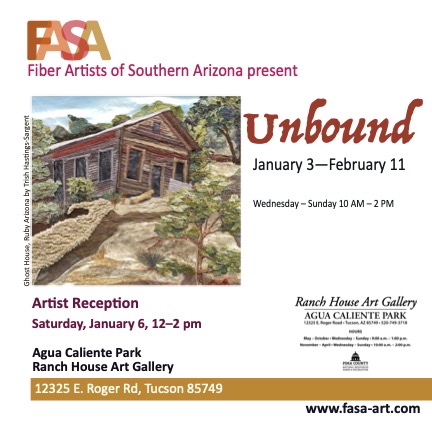
This will be the first installation of all 20,000+ pairs of baby booties!
oct save the date flyerI created this in response to a call for art to the members of Art Cloth Network by the Kemerer Museum of Decorative Arts in Bethlehem, PA. The show’s theme is “Luxury and Industry.”
I was able to research the silk industry in America (yes, really!), the role of women and child laborers, and union organizing by the mighty Mother Jones. Online searches for images of ‘child labor textile industry’ revealed nearly identical photos, taken a hundred years apart in the US (then) and overseas (now).
That got me thinking….
As I made the piece, news organizations reported on the use of immigrant children who are applying for official status in the US in dangerous working conditions. And the loosening by states of child labor protection laws.
Everything old is new again.

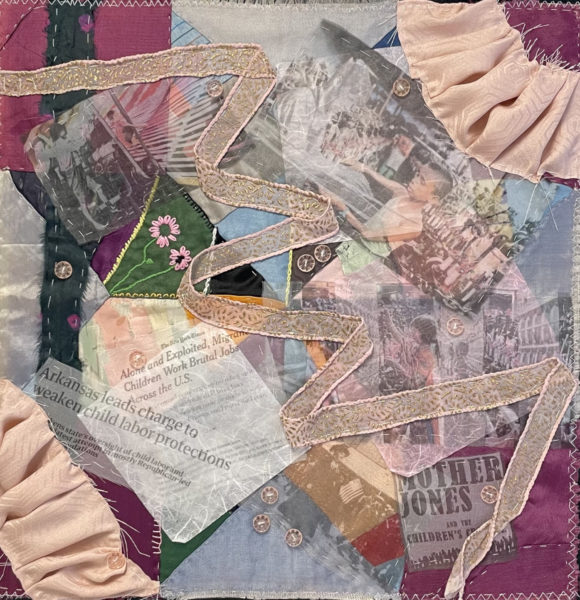
Materials: Vintage unfinished crazy quilt block, layered with vintage kimono scraps, hand-printed ribbon, collaged photographs printed on silk organza, antique glass buttons. Hand and machine stitch.
The Mourning Project is thrilled to bring this exhibition to the state capital building to talk to Arizona legislators about what they can do to improve the lives of babies in our state. Click here for a link to a video of the installation.

This 24 x 48” version of The Mourning Project: One Day features 63 pairs of handmade baby booties, one little elegy for each child lost before their first birthday every day in the US. It is a tiny portion of the 20,000 pairs we are collecting from makers all over the world to draw attention to the infant mortality rate in this country.
This version of the project will be at the Norfolk D’Art Center in Norfolk, VA for their Materials II exhibition, from October 10th, 2020-November 7th, 2020. Opening reception is Thursday, October 15 from 5:30-7:30 pm. The awards will be announced on Facebook Live, so stay tuned!
TMP makers–do you see your booties below? If not, check out the online installation by clicking here. Thank you to all who have contributed to save the lives of our most vulnerable citizens. Join us by submitting your booties today.
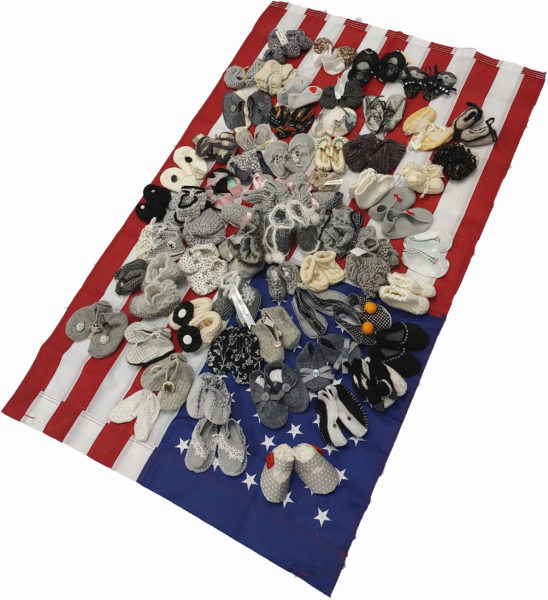
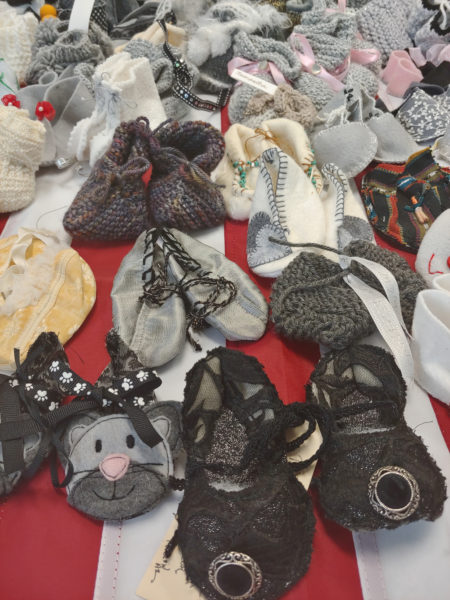
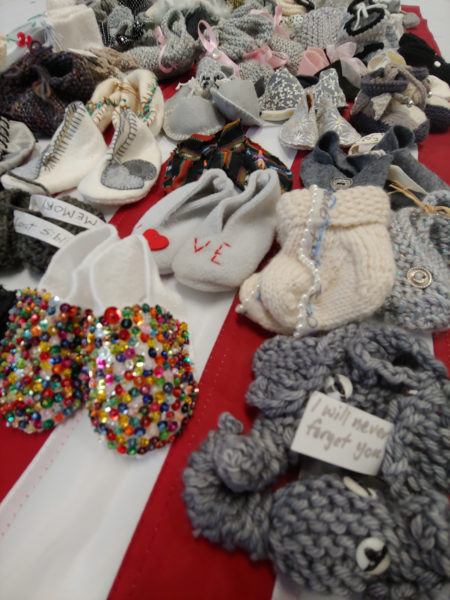
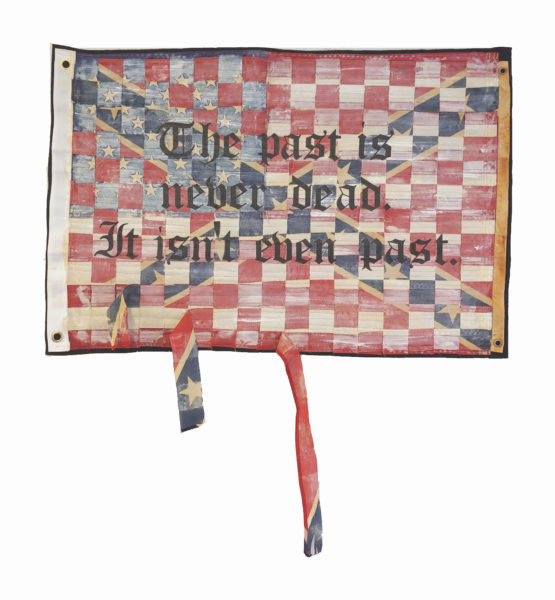
This piece was completed just in time for the call for submissions to the We Are the Story exhibition at the Textile Center in Minneapolis, MN. I was thrilled that Unravelling is part of the Racism: In the Face of Hate, We Resist portion of the show. The exhibit is curated by Dr. Carolyn Mazloomi and is getting a lot of buzz.
The quote is by William Faulkner, one of our greatest writers, and one of the first sons of the American South to feature relationships between black and white characters in his fiction. As flawed as Faulkner was on issues of race, his words very succinctly describe why we must work today to make amends for the systemic racism in our country today. For an ‘antiracist reading list,’ click here.
Materials: flags, woven and whitewashed, fusible web, hand-painted non-woven, felt, cotton backing, thread.

UnRavelling is a sister quilt to (White) Silence is Violence), which is also in the show. This piece was made in 2018 and is now in a private collection.

Another interpretation of the slings used by migrants crossing the border to carry water. This version incorporates found used clothing and a deconstructed American flag, layered with printed silk organza and hand stitching. Includes one carpet shoe found at the border. Printed text is from newspaper headlines about the Trump administration’s detention centers.

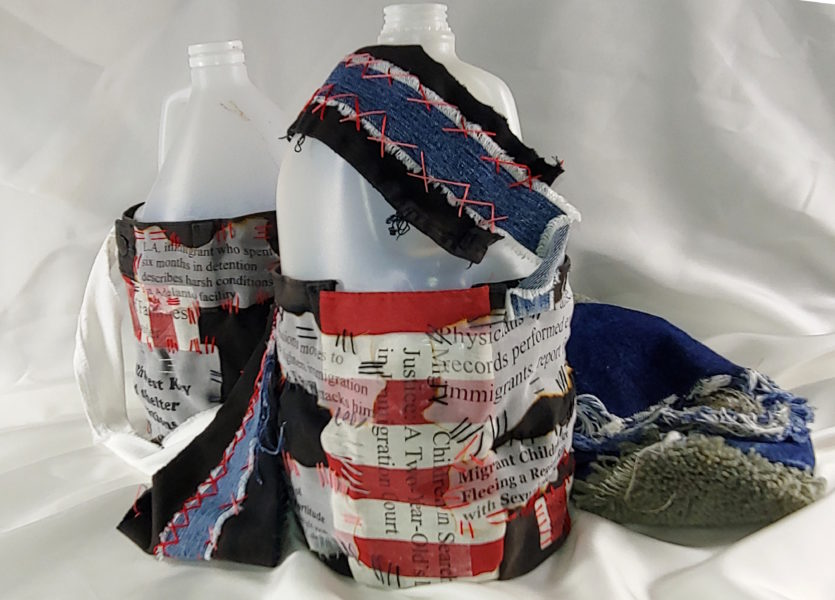
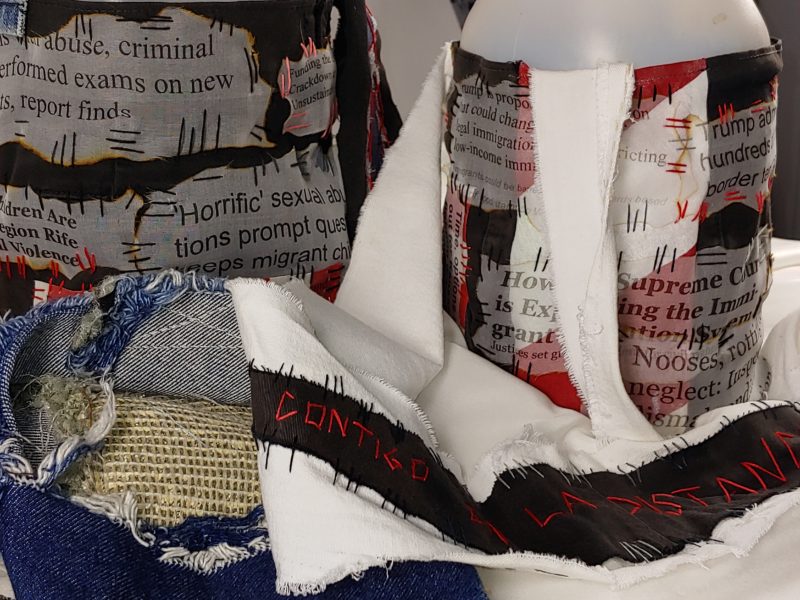
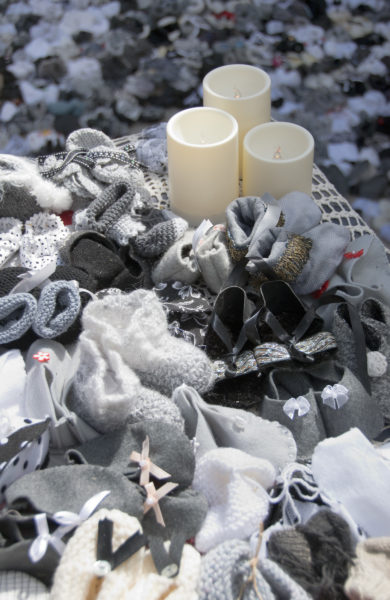
The Mourning Project is a huge community fiber art project to collect 20,000 handmade baby booties, one for each American infant who dies before her first birthday every year. The US has the worst infant mortality rate in the developed world. This project seeks to educate the makers and viewers about the issue, and start a discussion on how we can address this as a country.
The YWCA of Southern Arizona hosted the first installation of The Mourning Project, Little Elegies, April 2019 in Tucson. By this time makers contribute over 3,000 pairs of handmade baby shoes. These are some images of the first exhibition. Future installations will vary by venue as more makers donate booties.
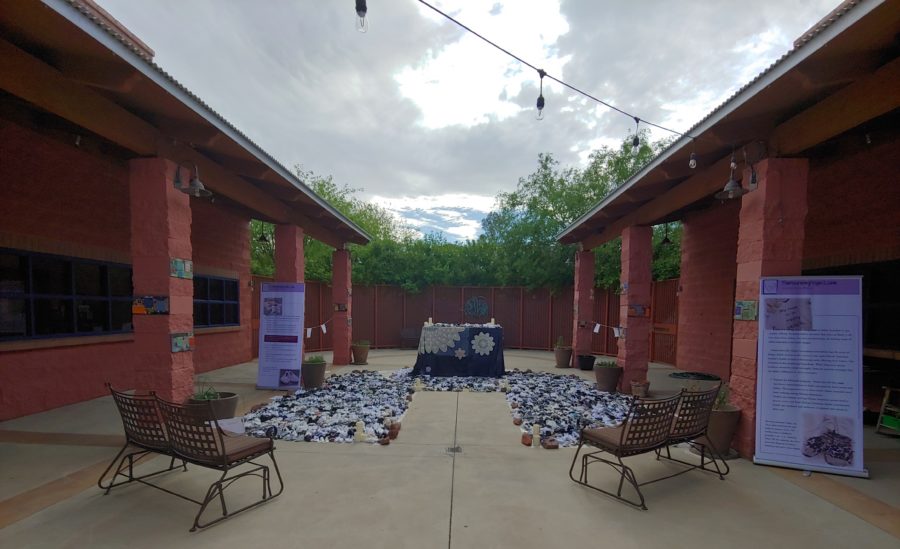

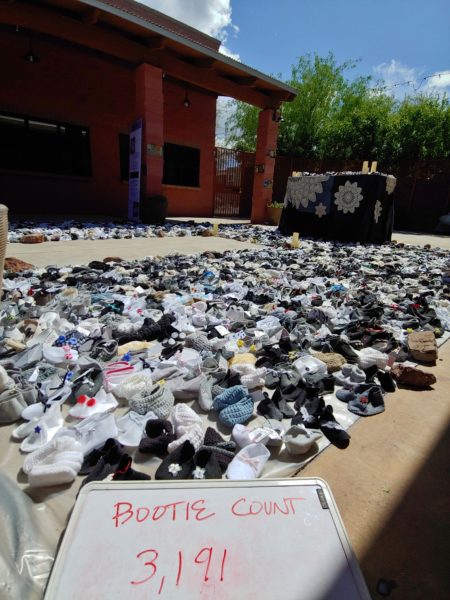


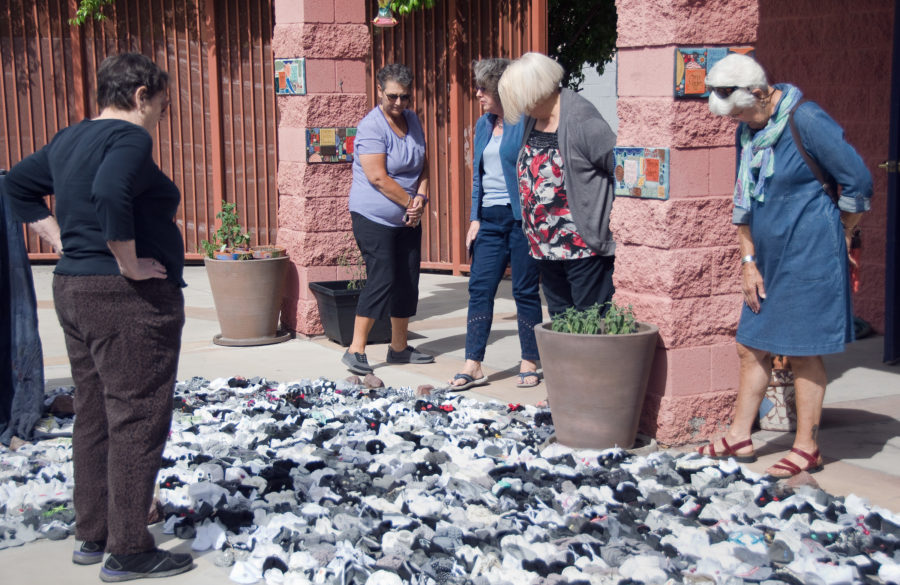
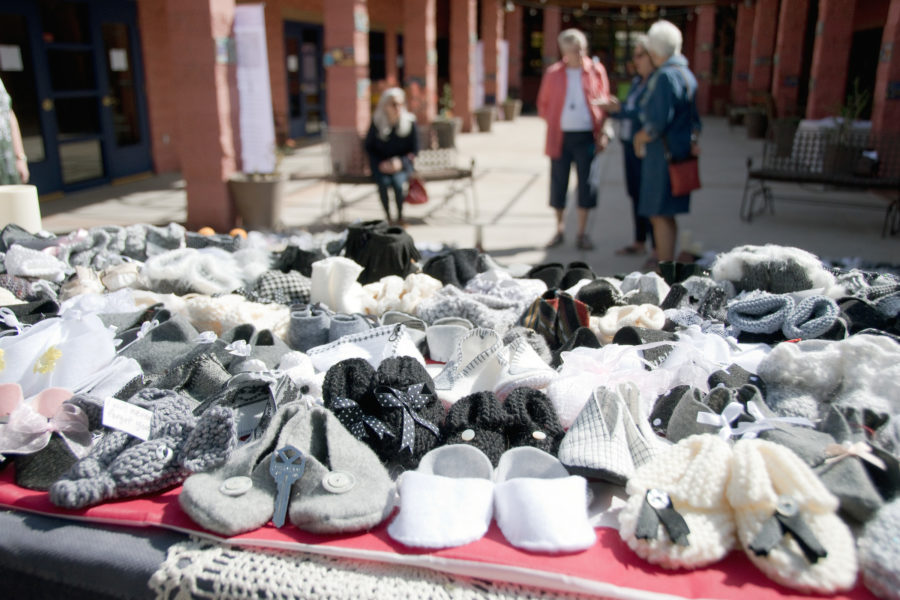
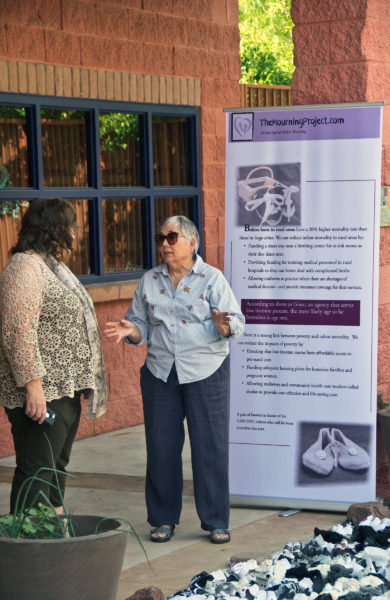
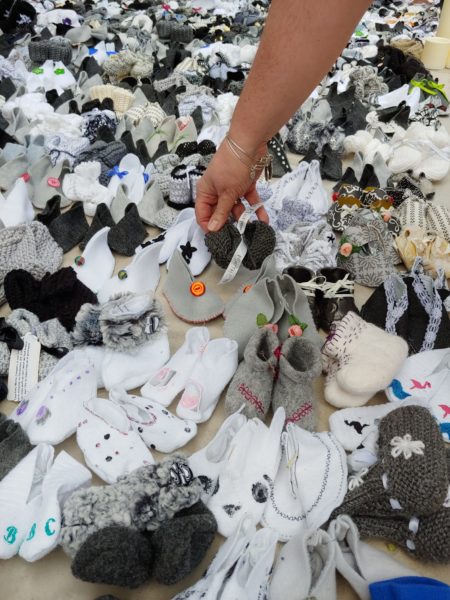
Let’s just say it’s been a whirlwind… It started with the installation, then the exhibition, meeting some of the local makers (two of my sisters flew in for the show), running the panel discussion, and finally, the de-installation. Phew. Here are some of the behind-the-scenes moments you might have missed…and did I mention the bootie haboob?
This first exhibition, at the YWCA of Southern Arizona, was an outdoor installation. (Note: for reasons that will soon be clear, I am re-thinking any future outdoor installations). Little Elegies would be in a large courtyard surrounded on three sides by brick and mortar, and on one side (the west side) with a steel security fence.

I visited the site multiple times, at different times of day, measured, and carefully sketched out this installation plan:

The curve of the installation plan follows the curve of the fence. The 8 foot fence runs all the way down to the cement floor, so no worries about packrats invading the installation and stealing booties (these are the things you must take into account in Arizona). The forecast was negative for rain, and this being Tucson, you could pretty much depend on that anyway. A few days before the installation, however, I realized I had not thought about the wind, or even worse:

I checked the weather forecast to see that the maximum winds predicted were 13 mph. Not exactly a storm, more like a gentle breeze. I researched fences online that would act as a wind break. There were none available in Arizona. I would have to order them, and they would arrive after the opening of the exhibit. I decided to punt and use duct tape and drop cloths if needed to keep the booties from going airborne. Paper booties were filled with coins to weigh them down. Ceramic booties helped to weigh down aspects of the installation (like the altar cloth) and stabilize them.
Late on Friday afternoon (March 29), we completed the installation. The awesome installation team of Mitch Anderson, Ana Martinez, Kathleen Koopman, Janet Windsor, Valerie Galloway put it together in under 4 hours and it looked great. The question was, would it stay that way until Tuesday morning when the show opened?
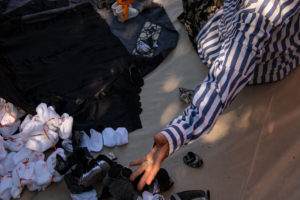
Click here for a link to Dan Buckley’s cool time lapse video of the installation.
When I arrived at 9:00 sharp on Tuesday, all was just as we had left it (we had secured the booties and rest of the installation with vinyl drop cloths and heavy rocks). It looked like I was home free, and the installation was ready for viewing at 9:00 a.m.

But about 1:00 on Tuesday afternoon, a gentle breeze blew in. By 3:00 there was some wind gusts, and the occasional pair of booties went tumbling like so many tumble weeds you see in the old westerns. I put up the drop cloths behind the fence with duct tape, which promptly fell off. ( I must have looked quite the sight battling the winds, the drop cloths, and the duct tape all at once.)
The wind came in from the west, directly into the courtyard, and I realized that the focal point of the installation was surrounded on three sides by the screen fence. So I covered the installation about an hour early, and went home to figure out plan B.
I had dinner that night with my husband and sister Kathleen AKA The Knitting Machine and told them the problem, that I needed ‘something with grommets’ to attach to the fence with zip ties and screen the wind. They had both used plastic tarps in the past and we headed over to a local hardware store and found just what we needed, in gray.
The next day, The Knitting Machine and I moved the entire installation 20 feet east, where it was better protected from the wind. Then we installed the tarps behind the existing fence. All on Wednesday morning, before the winds picked up again. It was so great to have Kathleen there to help. She sure knows how to whittle down a To Do List, and she’s fun to hang out with, too.
Thursday was busy with preparation for the panel discussion. Panelists Bonita Katz of the International Childbirth Education Association, Stacie Wood, TMC’s Perinatal Safety Officer, and Laura Vargas, March of Dimes Advocacy Fellow gave great presentations on how we can begin to make improvements in our infant mortality rate. Click here for an edited video of the discussion and learn more about the problem.
Friday morning we had a bunch of local makers in for a photo shoot with the installation. Stay tuned for a picture of that. In the meantime, here are some views of the installation throughout the week. Scroll down to see some of my photos of the installation. And then you can read about the BOOTIE HABOOB.

There are three banners that accompany the installation. This one describes the installation, and the other two discuss the problem of infant mortality.

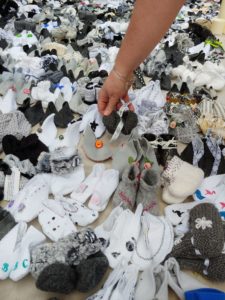

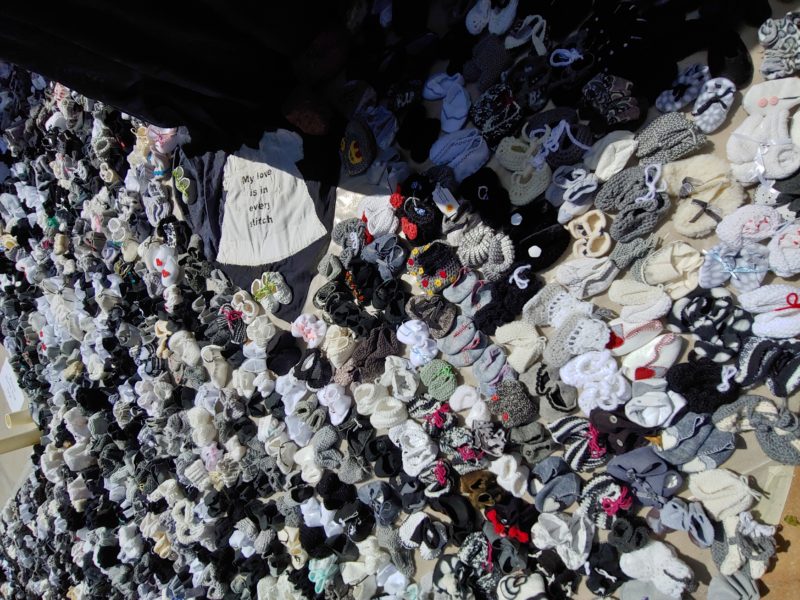

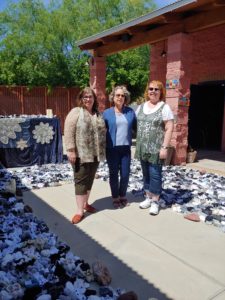
So, all of that happened, and Friday passed without windy incident. Until about 4:00 on Friday, the exhibition over, and it was time to start collecting the booties. The sky had started to darken. By 4:30, half of the booties were packed. Then a HUGE gust of wind came from the east, behind and up and over the building, and it swept a whole bunch of booties around the altar and up against the fence. It happened in about two seconds. And I so wish I had video of the bootie haboob to show you, but you will just have to imagine 1,500 booties tumbling in the wind.
It was just one hellacious gust, and we (JK, Nanci, Kathleen and I) scrambled to collect them all. No harm was done. All the booties were collected and undamaged. I have a better idea to hold the booties down IF there is another outdoor installation.
Do you see your booties in these photos? Please make some more! Make them black, white, and gray, knit, sewn, or crocheted. Be sure to send in your booties by Mother’s Day, May 12, and we will extend the deadline if necessary. We still need 20,000 more pairs to honor each American baby who dies each year. I know you will want to be a part of this important project.
And thank you to all the makers who have submitted booties to date! The Mourning Project is possible with you.
PS–Watch this blog and our Facebook page for professional photos of the exhibition. I’ll be using those to apply to different venues for the exhibition around the country. If you have an idea about where we should apply, let me know!
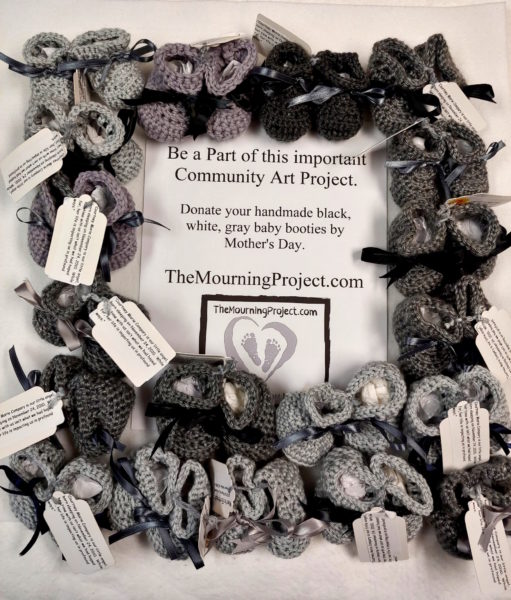

It was so touching to get this box of 20 little elegies. Merle Eintracht made each one in memory of Courtney Marie Campary. Merle heard about TheMourningProject.com‘s goal to collect 20,000 baby booties from her neighbor. Courtney was the beloved daughter of Kirsten and Phillip. Merle labelled each pair of baby booties, noting Courtney ‘was born sleeping on November 24, 2010. While her time with us wasn’t what we’d hoped for, her life is impacting us in profound ways.’
Merle continues: ‘At the time of Courtney’s birth, I had no idea of what I could do to lessen Kirsten’s pain. You project has allowed me to help in a meaningful way. I have sent photos to Kirsten every step of the way. The booties have both overjoyed her and made her cry all over again.
Kirsten will NEVER forget her little girl.
Your project will have many more people know that Courtney Marie Compary was the long awaited daughter of a couple who have endless love for each other and will forever have endless love for Courtney.’
I have no words for the generosity of spirit in Merle’s contribution to TheMourningProject.com. But that generosity extends to Kirsten as well. She has gone on to help others who have lost their little ones. You can read the amazing story here.
It is stories like these that remind me how personal this project is for so many people, and how the lives of these lost little ones impact so many. I am so grateful that the project touches so many hearts. It is the first step to changing the world.

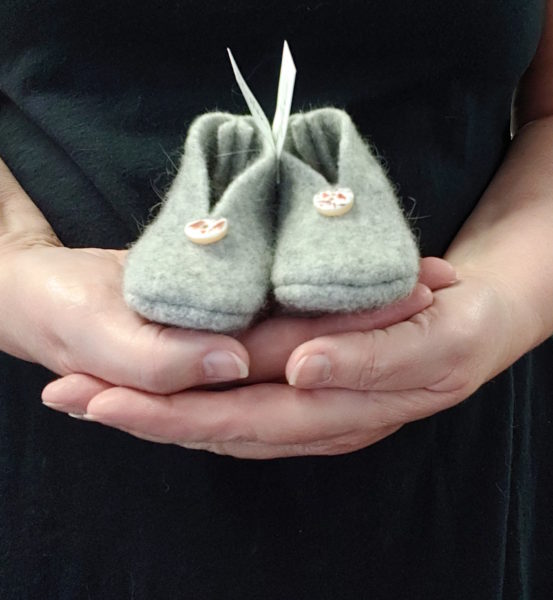
Heartbreaking, and Heartwarming
My friend Trish told me a story this week that both broke and warmed my heart. She lives in Three Points, Arizona. It is a literal wide spot in the road with a population of about 5500 people. Most residents know each other through the churches or other organizations. Trish is a big fan of TheMourningProject.com and has been talking and writing in the local newsletter about it. She told me that, recently, a Three Points mom lost her three day old daughter to hydrocephalus. The whole town grieves with this mother and are supporting her as she tries to recover from this terrible loss. When they heard about The Mourning Project, local volunteers pledged to make 100 pairs of baby booties in memory of this one beloved child.
This love and generosity brings tears to my eyes. Trish’s story reminds me that this project is about so much more than one person or a cause. It is about all of us coming together to acknowledge our loss, and begin to heal, and right this wrong so that it doesn’t happen needlessly to any parent.
So for all of you working on your baby booties, thank you. Together, we are going to make a difference.
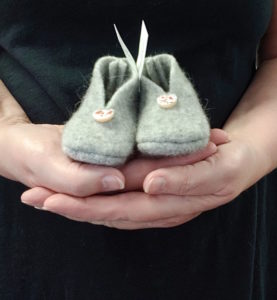

The Weight of Water by Mary Vaneecke, 20” x 20” by 12”
When I attended a photo shoot for The Migrant Quilt Project I was struck by the fabric slings for water bottles that Jody Ipsen brought from campsites along the border. Jody is the founder of the MQP. Crossers or their loved ones or immigrants rights groups make these slings hastily. They sometimes include encouraging messages like bueno suerte (good luck) or contigo en la distancia (with you on your journey). It hit me how these migrants had to carry enough water with them to survive their journey. They had to decide what to carry with them across the border, and what to leave behind on their way to a new life.
The items left at campsites or layups tell of a journey fraught with peril and loss. Jody allowed me to photocopy pages from a book for prayers to Santa Muerte, or Saint Death. Santa Muerte is important because she can protect crossers from violent death. Jody also shared copies from a small notebook filled with handwritten poetry or Verzos. (One of those poems is for Mother on Mother’s Day.) Ten dollars worth of pesos secreted into hand-stitched hems is another frequent find. Migrants often carry milagros or votives with them. Empty gallon jugs and carpet shoes, which mask footprints when worn over street shoes, are common in layup sites along the border.
My version of these slings include headlines from American newspapers about the official policies dealing with migrants, as well as reproductions from prayer and poetry books found on the border.
Found objects (water bottles and carpet shoes), deconstructed American flag and denim jeans, vintage mola (maker unknown), milagros, woven textiles from South and Central America (makers unknown), silk organza, cotton, vintage Mexican flag collectible, Virgin de Guadelupe fabric, facsimiles of found objects, fusible web.
Machine and hand stitch, image transfer, fusing, applique.
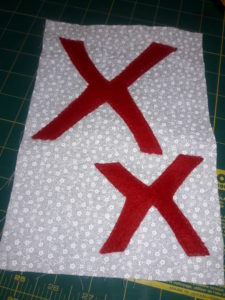
Have you read the article on the New York Times about the trends in political fiber art, or “craftivism”? (I hate that word-it feels like it diminishes the work) The article’s an interesting summary of political fiber art since the 1970s. Click here for the full text. As a fiber artist and someone who has studied public policy, I admire the works of Sheila Hicks, Faith Ringgold, and Anni Albers. Art in any form can enlighten, or change someone’s mind, and cause a spark of empathy and recognition. As Toni Morrison said, All good art is political.
While you may have heard of Threads of Resistance, which is showing around the country, there are two ambitious community fiber art projects with open calls right now. One memorializes a forgotten Nazi atrocity (this would not seem terribly political, and yet Nazis and white supremacists in the U.S. are feeling emboldened these days). The other seeks to have a conversation about the border wall. Neither one of these projects can be done without community participation. If one or both speaks to you, you have an opportunity to contribute.
The 70273 Project by Jeanne Hewell-Chambers memorializes a forgotten Nazi atrocity, the murder of 70,273 disabled people. She is collecting a quilt block (two red x’s on a white ground) for each of those lost and has an army of volunteers helping her assemble them into quilts. Want to read more? Click here. I sent my block several weeks ago, in honor of my cousin Paul, who has Downs Syndrome. It is shocking that I feel compelled to take a stand against Nazis in America. In 2018. But there you go.
On a related note, Lea McComas is working on a ‘quilted’ border wall project. If you are a quilter with an opinion (pro or con) on the planned border wall, you may want to participate. The online call is posted here: http://borderwallquiltentry.com/. The deadline for the call of 8″ x 16″ ‘bricks’ is July 31. Lea is hoping to exhibit the wall in Houston in the fall at the annual quilt show.
Regular followers of this blog will not be surprised that I have have an opinion on the wall. I appreciated the pragmatic and succinct view of Janet Napolitano, former Governor of Arizona and Secretary of Homeland Security, and incorporated a quote by her in my piece:
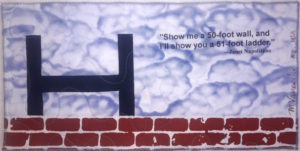
I am working on a large community fiber art project of my own. It’s not ready for prime time yet…stay tuned.

Wow. This wonderful AP article has been in the NY Times, Washington Post, Boston Globe, and the LA Times. Click here for the article. Scroll down to see an image of my Desconocidos quilt. The piece has been travelling as part of the Migrant Quilt Project and is now at the New England Quilt Museum in Lowell, MA.
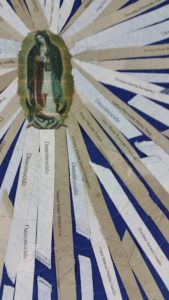
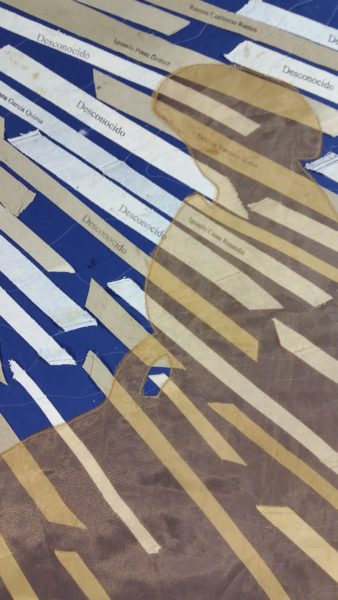
Just a quick link to a local news story about the Migrant Quilt Project I am involved in. We are preparing quilts for a national tour including the New England Quilt Museum in Lowell, Massachusetts and the International Quilt Study Center and Museum in Nebraska. Click here for the news story.
This is the quilt I did for the project last year. It features a silhouette of Fr. Kino, the first European in the Tucson area, who I consider our first border crosser. Yes, he came south to Tucson from what we call Mexico today.

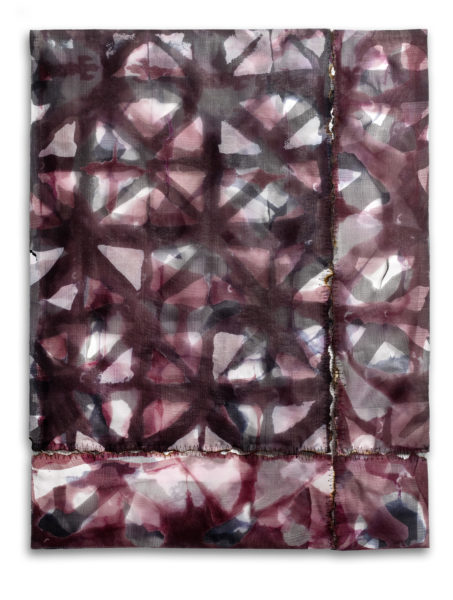
New Work: Back to ‘Mending’
Yet another new work inspired by Hazel Hall’s poem, “Mending.” Full text of the poem is here. Written about 100 years ago (Hall died in 1924), it is the gift that keeps on giving! Hall describes a mundane household chore as a subversive act, ‘a little travesty on life.’ It just seems to fit our zeitgeist, doesn’t it?
This piece combines several of the techniques I have used in the last year: layered sheers, cutting, burning, and visible mending. It feels radical to me, but still beautiful. Similar to Haiku III, but dimensional instead of fused flat. Best of all, I have ideas for several more pieces in this style.
Stay tuned.
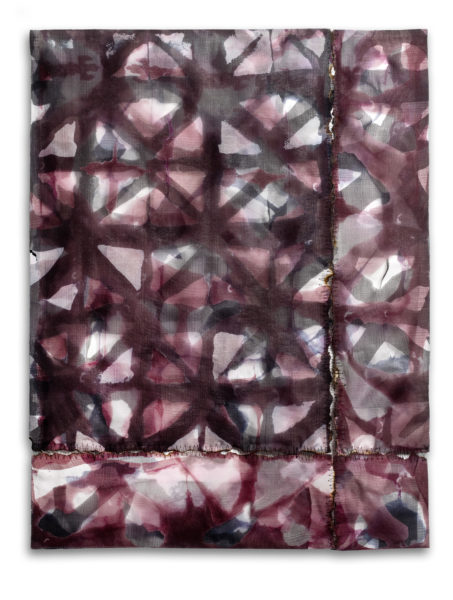

Fabric, dyes, fusible web.
Fusing, dyeing, burning, machine stitch, cut work.
photo credit: Jack Kulawik

When officers of the law become judge, jury, and executioners, killing unarmed black citizens, we all have a problem. The police act on our behalf. This slogan from the Black Lives Matter movement challenges our complicity in the face of these injustices. It demands our attention. We must find a way to hold our police officers close, and still hold them accountable. This piece is included in the Studio Art Quilt Associates Loaded Conversations exhibition.
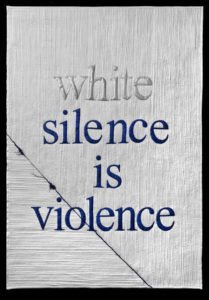
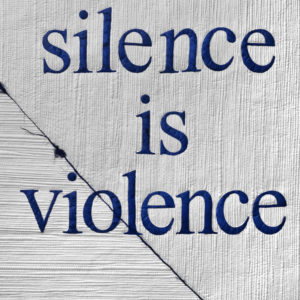
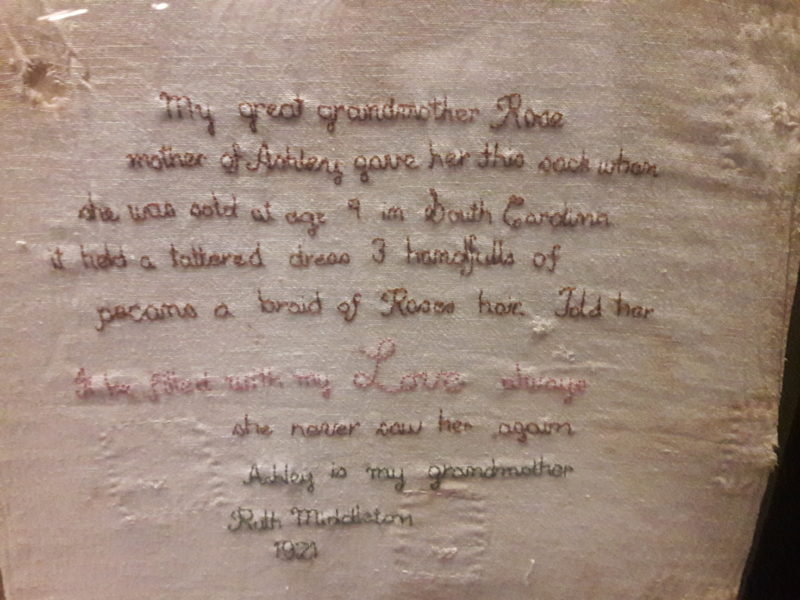
I spent a week in Washington D.C. this summer and the highlight of the trip was two visits to the National Museum of African American History and Culture, aka the Blacksonian (according to VSB). I wasn’t sure I could get in, because tickets are sold out months in advance. A guard suggested I get in line at noon and wait till one o’clock when all the unclaimed will call tickets are released for the day. It means you have only half a day to see the museum with that ticket (unless you wait in line another day, like I did), and you are not guaranteed tickets, but it is well worth the chance to get look at this amazing museum. Every American needs to see it.
More than half of the Blacksonian is below ground, so it is much larger than it looks from the mall. The lower floors focus on the history of slavery/emancipation/Jim Crow/segregation and the Civil Rights era. The upper floors are displays of African American contributions to the arts and athletic achievements.
It was thought that the average visit would be about 3 hours, but it is more than 6 because there is so much history, and so many meaningful displays to see. And this is history we don’t read about in school. It is difficult to just walk briskly by a pair child-sized shackles. A looming guard tower from Angola prison. A chapel for the casket of Emmett Till. At least half the exhibits and displayed items just stop you dead in your tracks.
I am going to post just a few pics of textile-related items. The first is this gorgeous piece, a silk and linen shawl given to Harriet Tubman by Queen Victoria. Think about that. A woman born a slave in the USA could not only capture the attention of the Queen of England, but receive such an exquisite gift from her.
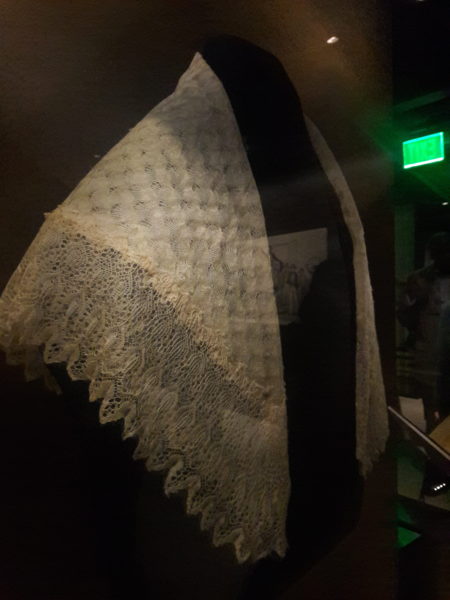
And this piece, a beautiful whitework dresser scarf. I believe it is one of the few pieces documented to have been created by a slave. Quilt historians had thought most of the fine quilting was done by plantation mistresses (neither would have signed their work). We are discovering now that is not always the case.
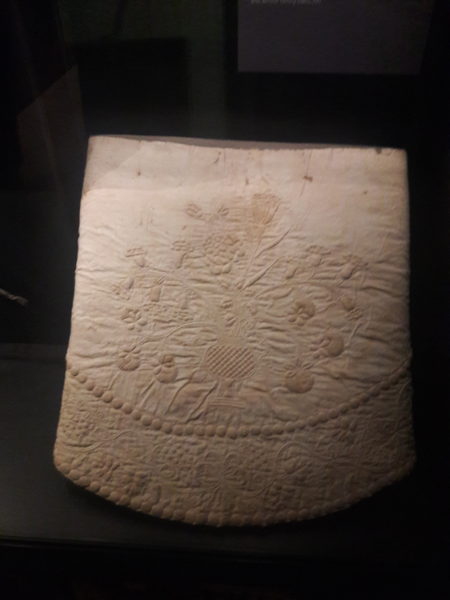
But this last piece took my breath away. It is called Ashley’s Sack. It was given by Rose, a slave on the Middleton Place Plantation in Charleston, to her nine year old daughter Ashley on the occasion of Ashley being sold away. Rose filled the sack with a few handfuls of pecans, a lock of her hair, and ‘her love always.’ The two never saw each other again. In 1921, Rose’s great granddaughter Ruth Middleton embroidered their story onto the sack.

This family kept this sack for generations. Like the museum itself, it is a treasure.
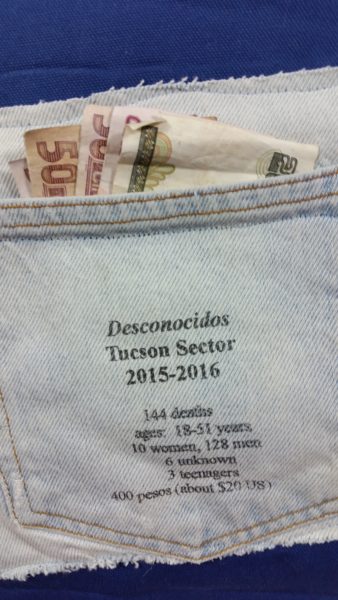

This piece was commissioned by The Migrant Quilt Project to honor and call attention to those who died crossing the border in the 2015-2016 fiscal year. It is made in part with clothing discarded at the border by migrants. The Project commissions a quilt each year, and the quilt must have the names of those whose have died while crossing, or, in the case of unidentified bodies, the word desconocido (unknown or stranger in Spanish). It was an honor to make this piece with Julia Moore, a high school intern who worked with me this winter. TMQP has received a grant for travelling exhibitions of these quilts beyond Tucson. Watch my blog for the next venue.
At the corner of East 15th Street and Kino Blvd. in Tucson is a monumental equestrian statue of Fr. Eusebio Francisco Kino. He was the first European to come to the area. He is, in a sense, our first border crosser. The statue (by Julian Martinez) looms large above the intersection and for years, I confess, I have wanted to quilt bomb it with an immigration theme. I am not sure how that is possible without access to a cherry picker. Not so subtle! I made a transparent silhouette of the statue to incorporate into this piece. The quilt also features a Virgin of Guadalupe, a marijuana-themed bandanna, and 400 pesos (which I found secreted into the hems of two pairs of jeans). Money and drug cartels frequently prompt these attempted crossings.
The numbers for Desconocidos The Migrant Quilt Project this year? One hundred forty-four deaths. The identified are aged 18-51 years. Ten women, 128 men, 6 unknown. Three are teenagers.
Materials: fusing, clothing, synthetic sheers, thread, canvas, felt.
Techniques: Burning, machine quilting, fusing, embellishing, image transfer.





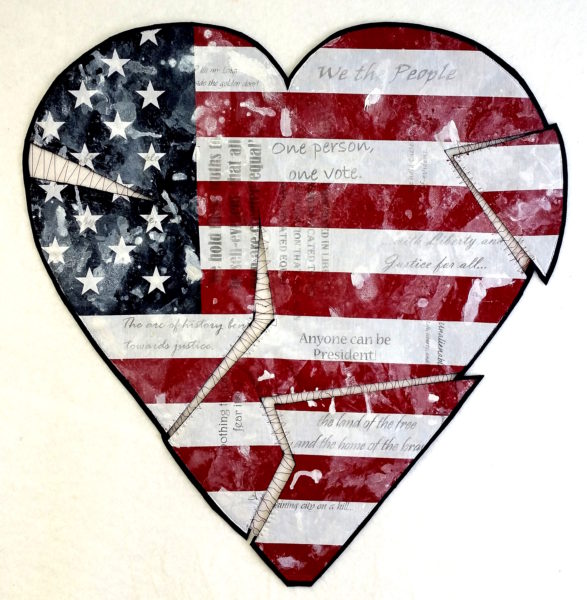
Hazel Hall’s poem ‘Mending’ reveals mending as a subversive act, an act of defiance, ‘a little travesty.’ Those who disagree with the current administration must put aside our shock and grief at the loss for what we thought America was, and fight for American ideals, to mend what is broken in this country.
Those who work in textiles have a long history of political activism. Like Betsy Ross. Or Madame Defarge. Watch Threads of Resistance for many political art quilts, or little travesties.


The full text of the poem is here:
Here are old things:
Fraying edges,
Ravelling threads;
And here are scraps of new goods,
Needles and thread,
An expectant thimble,
A pair of silver-toothed scissors.
Thimble on a finger,
New thread through an eye;
Needle, do not linger,
Hurry as you ply.
If you ever would be through
Hurry, scurry, fly!
Here are patches,
Felled edges,
Darned threads,
Strengthening old utility,
Pending the coming of the new.
Yes, I have been mending …
But also,
I have been enacting
A little travesty on life.
The Tucson Quilters Guild Quilt Fiesta! 2017 is all over, but this one was even more interesting that usual for me. One of the show co-chairs confided in me that my entry Abuela Reads the Headlines caused some controversy at the quilt show. Apparently at least two people asked that it be removed from the show show. Here is a pic of the piece:
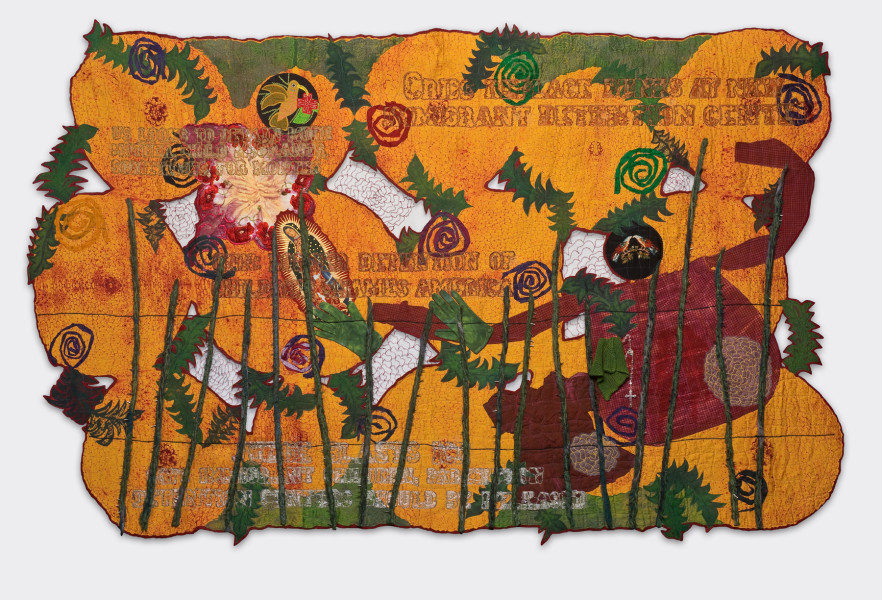
I believe the controversial part is the 2015 headlines from mainstream media that appear on the quilt. They are:
And, what is for me, the kicker:
But my quilt was not the only one to cause a stir. My friend Sandy Lambert had an incredible piece called ‘Lest We Forget.’ It is entirely hand quilted and embroidered with quotations by Republican presidential candidates, along with tombstones with the various dates of their campaigns’ demise.
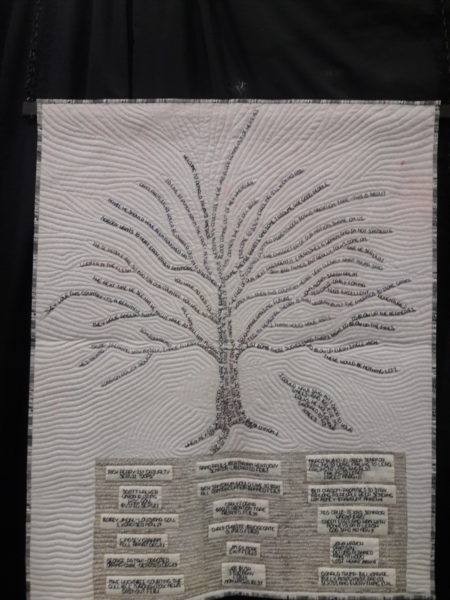


Several people confronted the show co-chair, Reilly Zoda and asked (perhaps demanded?) that the quilts be removed from the show due to their political content. She said that there was a Quilt of Valor at the show (and that was a political quilt), and a patriotic Baltimore Album quilt, and that was political, and if the show was going to censor political quilts, they would have to take them all down. What a brilliant response.
I am so proud that the show chairs refused to remove the ‘offending’ quilts. They were courageous in refusing to censor free expression at the show. We all know women have long expressed their hopes, dreams, and political beliefs in quilts, and the Tucson Quilters’ Guild honored that part of our tradition this weekend. The actions of the TQG stand in stark contrast the actions of the AQS over a quilt by Kathy Nida. (If you are unfamiliar with the case, google it, or click here, here, and here.)
Our foremothers would be proud!
I am holding my breath, however. I fear that this will be a hot topic at the next board meeting, and there may be a new policy in place for next year…. I will keep you posted.
I know from experience that the guild will hear 10 negative comments for each positive one. If you agree with their decision to allow ‘political’ quilts in the show, please let them know!
I just had to tell you all about my all-to-brief trip to the San Jose Museum of Quilts and Textiles. I was invited to give my artist talk, Confessions of a Subversive Stitcher, on the closing weekend of Art Cloth Network’s Anything Goes show. My fellow ACN member Connie Tiegel picked me up at the airport–and brought cake for the reception! I had never been to the museum, and I was so eager to see how it compares to some of the other quilt museums I have been to.
The first thing I noticed was the space. The galleries are incredible! There are multiple large galleries with great lighting, and tall, tall ceilings. They highlighted another show, THE CALIFORNIA ART QUILT REVOLUTION: FROM THE SUMMER OF LOVE TO THE NEW MILLENNIUM. That show included work from Kathleen Sharp, who currently resides in my hometown, Tucson. The show was an eye opener for me. Did you know, for instance, that subversive stitchers were quilting with dryer lint back in the 70s and 80s? I did not know that!
I was able to tag along on a tour the Curator of Collections Nancy Bavor gave of the ‘back room.’ We saw lots of acid-free boxes neatly labeled with accession numbers and such and learned the rare circumstances under which a piece can be de-accessioned. There was an area where all incoming textiles were quarantined for 2 weeks before being unpacked. Why? Bugs! Nancy looks for any evidence of insects that could infest the rest of the collection before they can do any damage. Who knew? Nancy is also a quilt historian, and was kind enough to compliment me on my knowledge of quilt history. It’s an important part of my talk, so I was relieved to hear it.

The Executive Director, Joan Phillips, is delightful. She is so enthusiastic about the museum’s greater focus on art quilts, including political works. The museum has big plans and is growing, it now has its second artist-in-residence, Cristina Velazquez. I met her was able to see some of her knitted work. Check her out on Instragram here.
Anything Goes looked fabulous in person. The next best thing is to click on the link and see the show digitally. Its next stop is the Kirkland Arts Center in Clinton, NY. Be there, or be square!
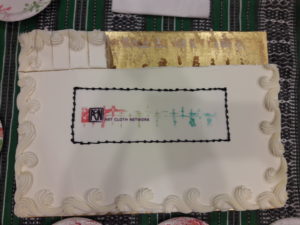
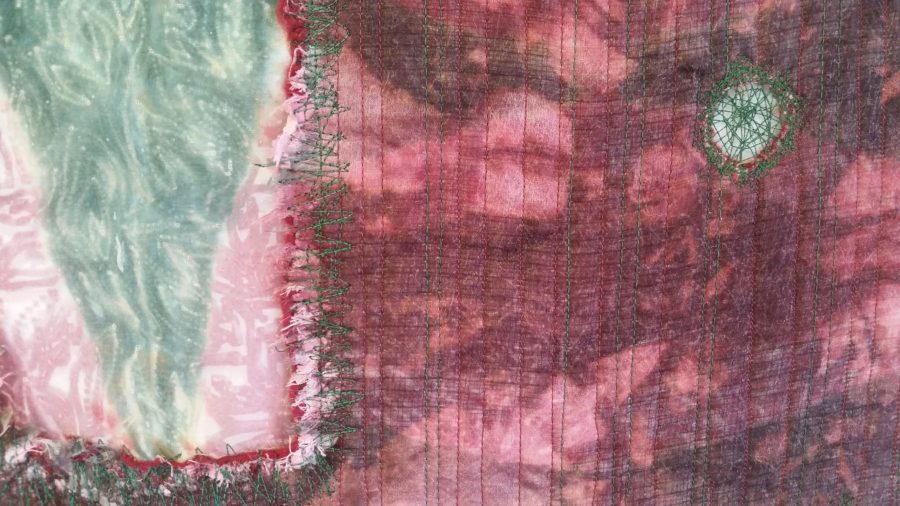
My latest art quilt, Yes, I Have Been Mending was inspired by 2 ideas. One is Hazel Hall’s poem, Mending. I recently discovered her poetry through Poets.org’s Poem-a-Day program. It is great to have a poem delivered to my in-box every day. I don’t always read it, but it is there! Hall used stitch imagery in several of her poems, so I was delighted to read her work.
The second idea that inspired me was the visible mending trend. It’s a lot like it sounds, but check out the link or Pinterest for some examples. ‘Yes, I Have Been Mending’ uses several gorgeous layers of hand-dyed silks, which I layered with eco-felt. And then I took an Exacto knife and sand paper to it to create holes. A bit of a travesty, but that is part of the poem! I then patched the red quilt with green thread and some more hand-dyed silks.
My favorite line in Mending is the last. The complete text of the poem is below:
Here are old things:
Fraying edges,
Ravelling threads;
And here are scraps of new goods,
Needles and thread,
An expectant thimble,
A pair of silver-toothed scissors.
Thimble on a finger,
New thread through an eye;
Needle, do not linger,
Hurry as you ply.
If you ever would be through
Hurry, scurry, fly!
Here are patches,
Felled edges,
Darned threads,
Strengthening old utility,
Pending the coming of the new.
Yes, I have been mending …
But also,
I have been enacting
A little travesty on life.
